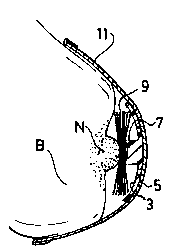Some of the information on this Web page has been provided by external sources. The Government of Canada is not responsible for the accuracy, reliability or currency of the information supplied by external sources. Users wishing to rely upon this information should consult directly with the source of the information. Content provided by external sources is not subject to official languages, privacy and accessibility requirements.
Any discrepancies in the text and image of the Claims and Abstract are due to differing posting times. Text of the Claims and Abstract are posted:
| (12) Patent Application: | (11) CA 2127325 |
|---|---|
| (54) English Title: | APPARATUS AND METHOD FOR CONTROLLING HUMAN LACTATION |
| (54) French Title: | DISPOSITIF ET METHODE DE CONTROLE DE LA LACTATION CHEZ LA FEMME |
| Status: | Deemed Abandoned and Beyond the Period of Reinstatement - Pending Response to Notice of Disregarded Communication |
| (51) International Patent Classification (IPC): |
|
|---|---|
| (72) Inventors : |
|
| (73) Owners : |
|
| (71) Applicants : | |
| (74) Agent: | GOWLING WLG (CANADA) LLP |
| (74) Associate agent: | |
| (45) Issued: | |
| (22) Filed Date: | 1994-07-04 |
| (41) Open to Public Inspection: | 1996-01-05 |
| Examination requested: | 2001-06-14 |
| Availability of licence: | N/A |
| Dedicated to the Public: | N/A |
| (25) Language of filing: | English |
| Patent Cooperation Treaty (PCT): | No |
|---|
| (30) Application Priority Data: | None |
|---|
An apparatus comprising a support having an outer surface and an inner
surface that is shaped to conform substantially to a human female breast and having a
protrusion which extends away from the support and is positioned to align substantially
with and contact a nipple of a human female breast prevents a human female breast from
lactating when placed over the breast. The present invention also provides a method for
controlling human lactation which utilizes the present apparatus and includes the steps of
placing and positioning the apparatus over the breast and applying pressure on the
apparatus sufficient to prevent lactation.
Note: Claims are shown in the official language in which they were submitted.
Note: Descriptions are shown in the official language in which they were submitted.

2024-08-01:As part of the Next Generation Patents (NGP) transition, the Canadian Patents Database (CPD) now contains a more detailed Event History, which replicates the Event Log of our new back-office solution.
Please note that "Inactive:" events refers to events no longer in use in our new back-office solution.
For a clearer understanding of the status of the application/patent presented on this page, the site Disclaimer , as well as the definitions for Patent , Event History , Maintenance Fee and Payment History should be consulted.
| Description | Date |
|---|---|
| Time Limit for Reversal Expired | 2005-07-04 |
| Application Not Reinstated by Deadline | 2005-07-04 |
| Deemed Abandoned - Failure to Respond to Maintenance Fee Notice | 2004-07-05 |
| Amendment Received - Voluntary Amendment | 2001-10-22 |
| Letter Sent | 2001-07-24 |
| Inactive: Application prosecuted on TS as of Log entry date | 2001-07-24 |
| Inactive: Status info is complete as of Log entry date | 2001-07-24 |
| Request for Examination Requirements Determined Compliant | 2001-06-14 |
| All Requirements for Examination Determined Compliant | 2001-06-14 |
| Application Published (Open to Public Inspection) | 1996-01-05 |
| Abandonment Date | Reason | Reinstatement Date |
|---|---|---|
| 2004-07-05 |
The last payment was received on 2003-07-04
Note : If the full payment has not been received on or before the date indicated, a further fee may be required which may be one of the following
Patent fees are adjusted on the 1st of January every year. The amounts above are the current amounts if received by December 31 of the current year.
Please refer to the CIPO
Patent Fees
web page to see all current fee amounts.
| Fee Type | Anniversary Year | Due Date | Paid Date |
|---|---|---|---|
| MF (application, 3rd anniv.) - small | 03 | 1997-07-04 | 1997-06-26 |
| MF (application, 4th anniv.) - small | 04 | 1998-07-06 | 1998-07-02 |
| MF (application, 5th anniv.) - small | 05 | 1999-07-05 | 1999-06-30 |
| MF (application, 6th anniv.) - small | 06 | 2000-07-04 | 2000-06-30 |
| Request for examination - small | 2001-06-14 | ||
| MF (application, 7th anniv.) - small | 07 | 2001-07-04 | 2001-06-26 |
| MF (application, 8th anniv.) - small | 08 | 2002-07-04 | 2002-07-04 |
| MF (application, 9th anniv.) - small | 09 | 2003-07-04 | 2003-07-04 |
Note: Records showing the ownership history in alphabetical order.
| Current Owners on Record |
|---|
| SUZANNE E. MORRISSEY |
| GERALD MORRISSEY |
| Past Owners on Record |
|---|
| None |